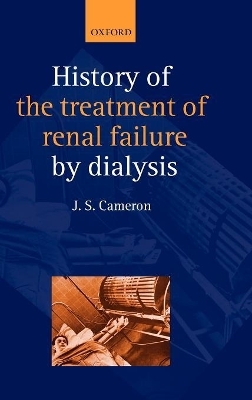
A History of the Treatment of Renal Failure by Dialysis
Oxford University Press (Verlag)
978-0-19-851547-0 (ISBN)
This book tells the extraordinary story of how the function of the first - and so far almost the only - human organ was replaced by a machine, and the "artificial kidney" entered medical and public folk-lore. A practical artificial kidney, or dialyser, came about by advances in science followed by the acquisition of new synthetic materials which made the application of these ideas possible. However it was the dedication and persistence of a number of talented pioneers who pressed ahead against professional opposition to achieve success, first in the treatment of temporary, recoverable kidney failure, and then permanent renal shut-down which made it a success. The apparent high cost and limited availability of this form of treatment immediately raised ethical questions which had never been questioned before, centering around equity of access to treatment, when and if treatment could be denied, and - worst of all - the agonising decision of when, once established, it should be stopped. Spiralling costs as the true number of people with kidney failure became evident raised major political and financial questions, which were addressed in different countries in different ways which reflected - but also helped change - patterns of how medical care is provided. In developed countries, the problem could be solved by allocating a disproportionate amount of money to the treatment of relatively few kidney patients, but in the developing world the cost of treatment still limits its availability, as it does all forms of modern health care.
Nevertheless, today almost one million people world-wide are maintained alive following terminal kidney failure, two thirds of them by various forms of dialysis and the remainder bearing kidney transplants, almost always placed after a period on dialysis. The story is also the sum of the often heroic lives of these hundreds of thousands of patients, a few of whom have today been maintained alive and active for more than 35 years, and many of whom suffered known, but also unexpected complications as a result of their treatment.
1. Why a history of dialysis? ; 2. Replacement of body function by mechanical means. ; 3. The science of dialysis: "uraemic toxins". ; 4. The science of dialysis: osmosis, diffusion and semi-permeable membranes. ; 5. Anticoagulants and extracorporeal circuits: the first haemodialysis. ; 6. The search for new dialysis membranes: the peritoneum and peritneal dialysis. ; 7. The first heamodialyses in humans: the introduction of heparin and cellophane. ; 8. The first practical dialysis machines. ; 9. Peritoneal and intestinal dialysis after the second world war. ; 10. The background: the emergence of acute renal failure as a syndrome. ; 11. The spread of dialysis treatment for acute renal failure: 1947-1960. ; 12. New designs of artificial kidney. ; 13. The role of dialysis technology in the founding of Nephrology. ; 14. New materials end new methods of access I: long-term haemodialysis becomes possible. ; 15. New materials and new methods of access II: long-term peritoneal dialysis becomes possible. ; 16. Dialysis patients in the 1960s and 1970s: old and new complications. ; 17. New technical advances and new problems. ; 18. Unexpected consequences: aluminium toxicity and dialysis amyloidosis. ; 19. Peritoneal dialysis transformed: CAPD. ; 20. Good news and bad news: treatment of anaemia, and the rising tide of diabetic nephropathy; withdrawl from dialysis. ; 21. The introduction growth of long-term dialysis during the 1960s in its fiscal and socio-political context. ; 22. Conclusion: dialysis today - and tomorrow?
| Erscheint lt. Verlag | 1.8.2002 |
|---|---|
| Zusatzinfo | numerous black and white photographs and figures |
| Verlagsort | Oxford |
| Sprache | englisch |
| Maße | 163 x 242 mm |
| Gewicht | 759 g |
| Themenwelt | Medizinische Fachgebiete ► Innere Medizin ► Nephrologie |
| Studium ► Querschnittsbereiche ► Geschichte / Ethik der Medizin | |
| Technik ► Medizintechnik | |
| ISBN-10 | 0-19-851547-2 / 0198515472 |
| ISBN-13 | 978-0-19-851547-0 / 9780198515470 |
| Zustand | Neuware |
| Haben Sie eine Frage zum Produkt? |
aus dem Bereich


